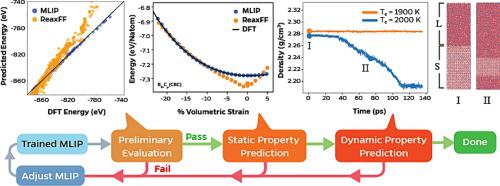当前位置:
X-MOL 学术
›
Comp. Mater. Sci.
›
论文详情
Our official English website, www.x-mol.net, welcomes your feedback! (Note: you will need to create a separate account there.)
Validation workflow for machine learning interatomic potentials for complex ceramics
Computational Materials Science ( IF 3.3 ) Pub Date : 2024-04-01 , DOI: 10.1016/j.commatsci.2024.112983 Kimia Ghaffari , Salil Bavdekar , Douglas E. Spearot , Ghatu Subhash
Computational Materials Science ( IF 3.3 ) Pub Date : 2024-04-01 , DOI: 10.1016/j.commatsci.2024.112983 Kimia Ghaffari , Salil Bavdekar , Douglas E. Spearot , Ghatu Subhash

|
The number of published Machine Learning Interatomic Potentials (MLIPs) has increased significantly in recent years. These new data-driven potential energy approximations often lack the physics-based foundations that inform many traditionally-developed interatomic potentials and hence require robust validation methods for their accuracy, computational efficiency, and applicability to the intended applications. This work presents a sequential, three-stage workflow for MLIP validation: (i) preliminary validation, (ii) static property prediction, and (iii) dynamic property prediction. This material-agnostic procedure is demonstrated in a tutorial approach for the development of a robust MLIP for boron carbide (BC), a widely employed, structurally complex ceramic that undergoes a deleterious deformation mechanism called ‘amorphization’ under high-pressure loading. It is shown that the resulting BC MLIP offers a more accurate prediction of properties compared to the available empirical potential.
中文翻译:

复杂陶瓷的机器学习原子间势的验证工作流程
近年来,已发表的机器学习原子间势(MLIP)的数量显着增加。这些新的数据驱动的势能近似值通常缺乏基于物理的基础,而这些基础无法为许多传统开发的原子间势提供信息,因此需要强大的验证方法来验证其准确性、计算效率和对预期应用的适用性。这项工作提出了 MLIP 验证的顺序、三阶段工作流程:(i) 初步验证,(ii) 静态属性预测,以及 (iii) 动态属性预测。这种与材料无关的过程在用于开发碳化硼 (BC) 的稳健 MLIP 的教程方法中得到了演示,碳化硼是一种广泛使用的结构复杂的陶瓷,在高压负载下会经历称为“非晶化”的有害变形机制。结果表明,与现有的经验潜力相比,由此产生的 BC MLIP 提供了更准确的属性预测。
更新日期:2024-04-01
中文翻译:

复杂陶瓷的机器学习原子间势的验证工作流程
近年来,已发表的机器学习原子间势(MLIP)的数量显着增加。这些新的数据驱动的势能近似值通常缺乏基于物理的基础,而这些基础无法为许多传统开发的原子间势提供信息,因此需要强大的验证方法来验证其准确性、计算效率和对预期应用的适用性。这项工作提出了 MLIP 验证的顺序、三阶段工作流程:(i) 初步验证,(ii) 静态属性预测,以及 (iii) 动态属性预测。这种与材料无关的过程在用于开发碳化硼 (BC) 的稳健 MLIP 的教程方法中得到了演示,碳化硼是一种广泛使用的结构复杂的陶瓷,在高压负载下会经历称为“非晶化”的有害变形机制。结果表明,与现有的经验潜力相比,由此产生的 BC MLIP 提供了更准确的属性预测。



























 京公网安备 11010802027423号
京公网安备 11010802027423号